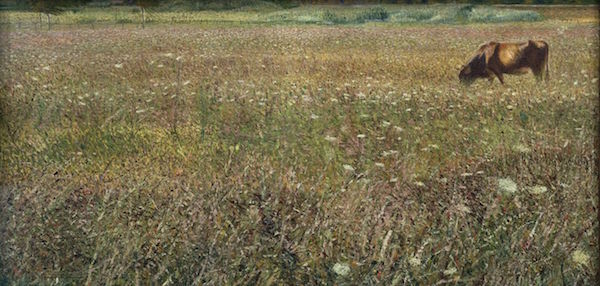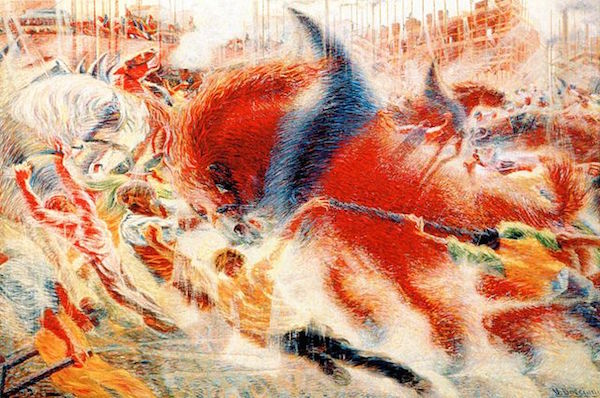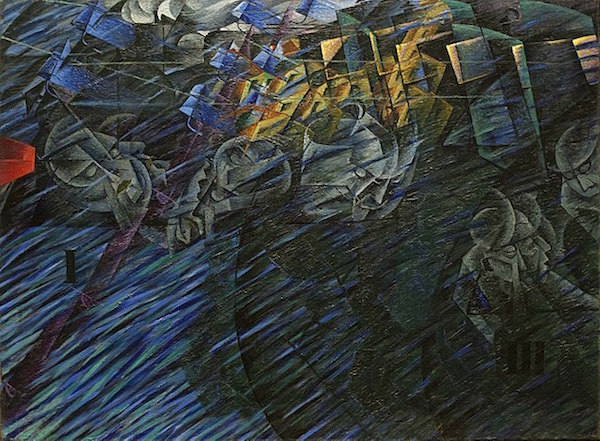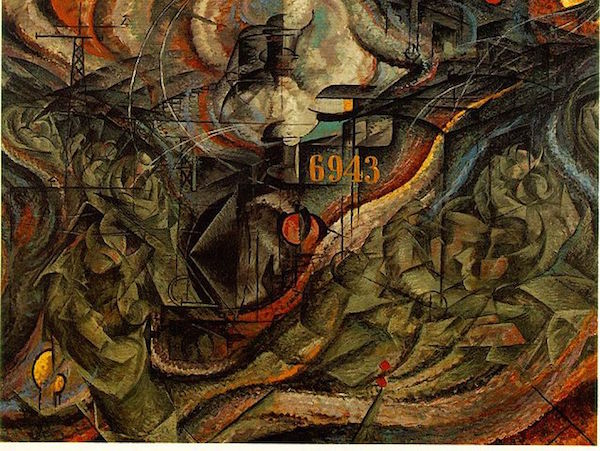Umberto Boccioni, The laugh, 1911 | © New York, Museum of Modern Art, Gift of Herbert and Nannette Rothschild
From 19 October140th anniversary of the artist’s birth, we will be able to admire them from the comfort of home in the documentary FORMIDABLE BOCCIONIwritten by Eleonora Zamparutti and Piero Muscarà with the direction of Franco Rado, produced by ARTE.it Originals in collaboration with ITsART and Rai Cultura and available exclusively on the ITsART platform. In the meantime, here is an overview of Boccioni’s most beautiful works preserved abroad.

Umberto Boccioni, Roman Campagna or Noon, 1903, Oil on canvas. MASI, Collection of the City of Lugano
At the MASI in Lugano, the Museum of Art of Italian Switzerland, we find the first oil painting of the budding genius: it is entitled Roman countryside or noon and it is dated 1903. Umberto was only 21 years old when he made this canvas: he recently lived in Rome and, with his friend Gino Severini, he attended the studio of the master Giacomo Balla. The MASI landscape is perfect but has nothing revolutionary about it, rather it reveals the foundations of Boccioni’s language, who will treasure the pointillist lesson to shake Italian painting from its foundations.
The street enters the house dated 1911 is kept at the Sprengel Museum in Hanover. From a whirlwind of shapes and colors, the figure of a woman from behind emerges in the foreground, leaning against the railing of a balcony in Milan, where the artist has moved. “The dominant sensation”, writes Boccioni, “is that which can be had by opening a window: all life, the noise of the street, burst simultaneously like the movement and the reality of the objects outside. The painter must not limit himself to what he sees in the window pane, as a simple photographer would do, but he reproduces what he can see outside, in every direction, from the balcony ”. Palaces, streets and construction sites come together in the vortex of the futurist vision, so powerful that it can bend its contours.

Umberto Boccioni, The road enters the house, 1911, Sprengel Museum, Hannover
Also in Germany, al Von der Heydt-Museum in Wuppertalwe can admire Simultaneous views (1912), almost a development of the Hanoverian painting: here the artist invites us to observe the street from top to bottom, in a dizzying perspective. The action takes place on superimposed levels and the deformation of the space is even more radical: the buildings curve and break down, like the figures captured in the street and the woman’s body leaning towards the void.
Instead, it is located at Londonat the Estorick Collectionoil on board Modern idol, icon of the new futurist beauty. A ban on the Venus of the past: in this painting, according to the art historian Niccolò D’Agati, the ideal woman is a cocotte with a flashy hat, who stops in front of a shop window, coloring her face with electric blue light. “In the early days of Impressionism, violet was accepted for meadows, skies, woods… Woe to see them on the face, arms, breasts of a beautiful woman”, Boccioni writes, proud of his transgression.

Umberto Boccioni, The rising city, 1910, Museum of Modern Art, New York
If al Metropolitan Museum of Art from New York we have an essay from Boccioni’s early years with two self-portraits (1904, 1905) and the guache Young man on the river bank (1902), al MoMa we relive the most fruitful season through some famous masterpieces. The rising city from 1910 “is perhaps Boccioni’s most heroic work due to the tension and the will to go beyond traditional pictorial forms”, observes the art historian Esther Coen. The artist himself defines this large painting as “titanic”, which attracts the viewer’s gaze towards the center of the canvas with “a red, glowing fireball” and a horse that moves the entire composition. Bright colors and brushstrokes charged with energy paint the landscape of a construction site on the outskirts of Milan with vibrant dynamism, the modern city that expands and ascends towards the sky.
Also at the Museum of Modern Arts in New York The laugh he transfers a universal emotion to the canvas, while the nightlife of the metropolis beats the rhythm on the canvas. It is now 1912 when Boccioni finishes this painting, and his language has further matured thanks to his stay in Paris, which gave him the opportunity to get to know Picasso and the Cubists. Witness the broken planes and the vision of the same subjects taken from different angles, while the bright colors and the movement imprinted on the whole return the sounds of a joyful, euphoric, almost delusional laugh. Great was the uproar that greeted this painting at the Free Art Exhibition in Milan, where a visitor expressed his disappointment by scarring the painting.

Umberto Boccioni, States of mind: Those who depart, 1912, Museum of Modern Art, New York
Boccioni’s research on human emotions continues in the series of Moods, which we admire at the MoMA in the second version (1912), probably the most successful. Set in a train station, the work consists of three paintings: Those who leave, Those who remain And The farewells. Here, too, there is an echo of the recent encounter with Cubism, which Boccioni re-elaborates in a rather personal way. In Those who leave the oblique lines of speed cut the faces of travelers, while the blue expresses their melancholy. In Those who remainon the contrary, the image of the companions standing on the platform is reinforced by vertical lines and on the canvas dominates the green, which in the artist’s vocabulary is the color of abandonment.

Umberto Boccioni, States of mind: Those who remain, 1912, Museum of Modern Art, New York
The farewells it represents the greetings and hugs that precede the parting: the lines are circular, the colors vivid, a vortex of reds, greens and blues interrupted by the white smoke of the locomotive. The reception, needless to say, was anything but calm: the French press shouted scandal, Boccioni’s art remained incomprehensible to most. The poet Guillaume Apollinaire, after seeing the Moodshe could only say: “I met an artist who is working on the theme of stations”.

Umberto Boccioni, States of mind: Farewells, 1912, Museum of Modern Art, New York
To the Museum of Contemporary Art of Sao Paulo in Brazil finally there is the plaster of Unique Forms of Continuity in Space (1913), the only handwritten testimony of Boccioni’s sculptural masterpiece. “Obsessed with sculpture” by his own admission, since 1912 the futurist master devoted himself body and soul to the renewal of what he now considered “a mummified art”. In Unique Shapes reinterprets the classic theme of the walking man in a futurist key, seeking a synthetic, intuitive and immediate representation of movement with brilliant intuition. Three-dimensional image of the new humanity advocated by Marinetti – the “new Icarus, half man and half machine” – Boccioni’s sculpture proclaims “the absolute and complete abolition of the finished line and the closed statue”: the figure “opens wide ”And welcomes the surrounding space, in a dynamic competition between object and environment. The bronze casting of Unique Shapes it was never made while Boccioni was alive: the metal sculptures exhibited at MoMa and MET in New York, at the Museo del Novecento in Milan and at the Tate Modern in London are dated between 1931 and 1972, while other plaster casts have gone lost in mysterious circumstances. We will find out from 19 October on ITsART in the documentary FORMIDABLE BOCCIONIalong with other excellent stories, curiosities and testimonies around the genius of Futurism.
![]() Read also:
Read also:
• “FORMIDABLE BOCCIONI”: the futurist genius in an unpublished docufilm
• Boccioni’s masterpieces to see in Italy

